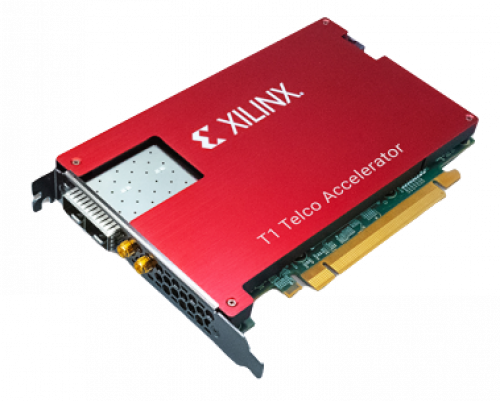Major telecoms operators around the world are getting behind Open Radio Access Network (O-RAN) and virtual Radio Access Networks (vRAN) to enable flexible software configurable 5G networks and to cut hardware costs. Both architecture types enable virtual baseband functions that run on off-the-shelf server hardware using general purpose CPUs, instead of traditional RAN where baseband is run in purpose built hardware using ASICs or SoCs.
One issue with virtual baseband functions is that they are highly compute intensive, especially for functions such as channel coding. To address this, channel coding specialist AccelerCommTM is using the Xilinx T1 Telco Accelerator card to increase performance by cutting latency, significantly boost encoder/decoder throughput, and dramatically cut the number of CPUs needed, all while enabling impressive cost reductions.
Making O-RAN work
A powerful telecoms accelerator card, the PCIe Xilinx T1 card offloads compute intensive functions in O-RAN distributed units (O-DUs) or virtual baseband units (vBBUs). Comprising a Zync UltraScale+ MPSOC and Zync UltraScale+ RFSoC, the programmable T1 card can be plugged into standard x86 or non-x86 servers to offload both fronthaul and L1 functions, replacing vendor specific baseband and fronthaul hardware. For O-RAN 5G NR layer 1 applications, AccelerComm™ delivers a complete high performance product ready, market-leading, production-grade LDPC chain for the Xilinx T1 card.
According to Xilinx, the T1 Telco Accelerator card delivers up to 45x encoding and 23x decoding throughput improvement compared to a server just using standard CPU cores.
In particular, the T1 card provides channel encoding/decoding based on a hardened LDPC codec, which is implemented as a configurable Soft-Decision Forward Error Correction (SD-FEC) hard IP block. This hardened LDPC core can be programmed with additional functionality on the programmable Logic to create a complete high-performance LDPC implementation to specific requirements.
Added LDPC performance
AccelerComm™ has developed a ready-to-use SD-FEC wrapper for the latest Xilinx T1 Telco Accelerator card that adds additional components to enable high performance LDPC encode and decode with a fully 3GPP 5G NR compliant LDPC chain, while still using the hardened RFSOC LDPC resource on the T1 card.
The AccelerCommTM design on the T1 card is based on an 8-lane PCIe with 6 decoders and two decoders to deliver unprecedented uplink performance of 8,055 Mbps and downlink of 20,296 Mbps. This uplink performance could be doubled by introducing modulation onto the card, while downlink performance can be improved by faster clocking or higher parallelism on the encode wrapper. The massive improvement in uplink speed balances downlink/uplink performance for 4G and 5G networks, removing constraints for live streaming and other real-time applications.
AccelerCommTM has also added additional logic to shift data at significantly higher speeds. Often, when passing information from the CPU to the Xilinx Telco Accelerator card, the PCIe bus becomes the bottleneck. The logic optimizes the T1 card and the code running on the CPU to enable bus utilization as high as 87 percent.
To implement the high performance LDPC solution, AccelerCommTM provides users of the T1 card with an image or bit file that can be programmed into the L1 Offload Xilinx RFSOC device on the Telco Accelerator card as well as O-RAN compliant software to be installed on the server.
O-RAN and BBdev
The T1 card holds much promise for the enablement of cost-effective O-RAN implementations. Currently O-RAN working group 6 is defining an open standard API called AAL from a number of candidates, BBdev from the DPDK organization being one of them. BBdev, or Base Band device, is an abstraction layer that decouples the application from hardware wireless functions, which appear as virtual devices.
AccelerCommTM has implemented its IP on the T1 Telco Accelerator card using the vendor-agnostic BBdev API as this gives operators a high performance card that is available and easy to use with compliant L1 software stacks. BBdev has support among many companies, including Intel, which originally initiated the API, and Xilinx.
Accelerated performance
Typically, L1 processing is around 40 percent of the server workload. With such a large portion of the workload doing LDPC an accelerator card using AccelerCommTM software offers a significant performance boost. Further, at higher bandwidths, many CPUs are needed to handle the LDPC processing. As the T1 Telco Accelerator card cuts the need for all these CPUs significantly, it brings down CAPEX.
There are many ways to accelerate LDPC coding from FPGAs to specialized processors and other cards such as the Intel N3000 which can all leverage the high performance AccelerComm TM IP. However, the combined solution from AccelerComm TM and Xilinx supporting the T1 card offers a fast, cost-effective way to boost performance of 5G networks by improving encoding and decoding throughput and reducing latency.
O-RAN scenarios
O-RAN uses an O-DU (Open Distributed Unit) to process L1 and real-time L2 functions. The T1 Telco Accelerator card is designed to offload O-DU functions that include channel coding, HARQ buffer management, rate matching and de-matching, and fronthaul eCPRI. It also provides sub-ns PTP time stamping, ORAN layer mapping for NICs, and hardware redundancy and fallback.
The Xilinx T1 card provides two SFP28 ports for fronthaul, making it suitable for two-sector with redundancy deployment. Here one SFP28 is used for traffic and the other for fallback. In another scenario, the card could provide a high RU/DU ratio by working directly with four sectors.
The Xilinx T1 card could also be used in a Front-Haul Gateway (FHGW) to offer the highest RU/DU ratio. The FHGW manages different 4G/5G remote radio heads (RRHs), that might have different splits or CPRI-based interfaces, enabling operators to use existing radios with O-RAN.
The AccelerCommTM LDPC solution for Xilinx T1 cards is available now, offering vastly reduced time to market for products with true 5G NR functionality. Operators can use the AccelerCommTM SD-FEC wrapper and server software to implement O-RAN or virtualized infrastructure today in a variety of scenarios.
